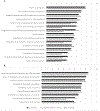Barriers and facilitators for emergency department initiation of buprenorphine: A physician survey
- PMID: 30803850
- PMCID: PMC7556325
- DOI: 10.1016/j.ajem.2019.02.025
Barriers and facilitators for emergency department initiation of buprenorphine: A physician survey
Keywords: Buprenorphine; Emergency department; Health services research; Opioid use disorder.
Conflict of interest statement
Disclosures:
ML, AK, JH, DAR, JP, ZFM report no conflicts of interest.
MKD received an honorarium for participating in an Expert Roundtable on opioid prescribing convened by United Health Group.
Figures



References
-
- Understanding the Epidemic. Centers for Disease Control and Prevention, National Center for Injury Prevention and Control, Division of Unintentional Injury Prevention, 2018. (Accessed December 15, 2018, at https://www.cdc.gov/drugoverdose/index.html.)
-
- Cunningham CO, Sohler NL, McCoy K, Kunins HV. Attending physicians’ and residents’ attitudes and beliefs about prescribing buprenorphine at an urban teaching hospital. Fam Med 2006;38:336–40. - PubMed
Publication types
MeSH terms
Substances
Grants and funding
LinkOut - more resources
Full Text Sources
Medical

